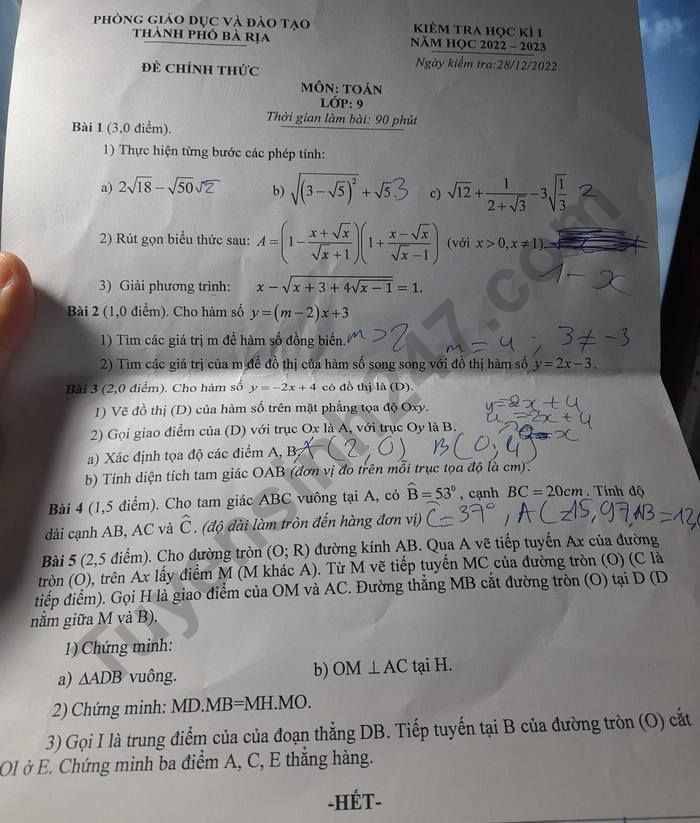
Hãy nhập câu hỏi của bạn vào đây, nếu là tài khoản VIP, bạn sẽ được ưu tiên trả lời.



Bài II:
a: Thay \(x=\dfrac{1}{4}\) vào A, ta được:
\(A=\left(\dfrac{1}{2}+1\right):\left(\dfrac{1}{2}-2\right)=\dfrac{3}{2}:\dfrac{-5}{2}=\dfrac{3}{2}\cdot\dfrac{-2}{5}=\dfrac{-3}{5}\)
b: Ta có: \(B=\dfrac{\sqrt{x}+2}{\sqrt{x}-3}+\dfrac{\sqrt{x}-8}{x-5\sqrt{x}+6}\)
\(=\dfrac{x-4+\sqrt{x}-8}{\left(\sqrt{x}-3\right)\left(\sqrt{x}-2\right)}\)
\(=\dfrac{\sqrt{x}+4}{\sqrt{x}-2}\)

\(b,B=\dfrac{\sqrt{x}+2}{\sqrt{x}-3}+\dfrac{\sqrt{x}-8}{x-5\sqrt{x}+6}\left(x\ge0;x\ne4;x\ne9\right)\\ B=\dfrac{\left(\sqrt{x}+2\right)\left(\sqrt{x}-2\right)+\sqrt{x}-8}{\left(\sqrt{x}-2\right)\left(\sqrt{x}-3\right)}\\ B=\dfrac{x-4+\sqrt{x}-8}{\left(\sqrt{x}-2\right)\left(\sqrt{x}-3\right)}=\dfrac{\left(\sqrt{x}-3\right)\left(\sqrt{x}-4\right)}{\left(\sqrt{x}-2\right)\left(\sqrt{x}-3\right)}=\dfrac{\sqrt{x}-4}{\sqrt{x}-2}\)
\(c,B< A\Leftrightarrow\dfrac{\sqrt{x}-4}{\sqrt{x}-2}< \dfrac{\sqrt{x}+1}{\sqrt{x}-2}\Leftrightarrow\dfrac{\sqrt{x}-4}{\sqrt{x}-2}-\dfrac{\sqrt{x}+1}{\sqrt{x}-2}< 0\\ \Leftrightarrow\dfrac{-5}{\sqrt{x}-2}< 0\Leftrightarrow\sqrt{x}-2>0\left(-5< 0\right)\\ \Leftrightarrow x>4\\ d,P=\dfrac{B}{A}=\dfrac{\sqrt{x}-4}{\sqrt{x}-2}:\dfrac{\sqrt{x}+1}{\sqrt{x}-2}=\dfrac{\sqrt{x}-4}{\sqrt{x}+1}=1-\dfrac{5}{\sqrt{x}+1}\in Z\\ \Leftrightarrow5⋮\sqrt{x}+1\Leftrightarrow\sqrt{x}+1\inƯ\left(5\right)=\left\{-5;-1;1;5\right\}\\ \Leftrightarrow\sqrt{x}\in\left\{-6;-2;0;4\right\}\\ \Leftrightarrow x\in\left\{0;16\right\}\left(\sqrt{x}\ge0\right)\)
\(e,P=1-\dfrac{5}{\sqrt{x}+1}\)
Ta có \(\sqrt{x}+1\ge1,\forall x\Leftrightarrow\dfrac{5}{\sqrt{x}+1}\ge5\Leftrightarrow1-\dfrac{5}{\sqrt{x}+1}\le-4\)
\(P_{max}=-4\Leftrightarrow x=0\)

Bài 2:
a: \(\text{Δ}=\left(-2\right)^2-4\left(m-3\right)=4-4m+12=-4m+16\)
Để pt vô nghiệm thì -4m+16<0
=>m>4
Để phương trình co nghiệmduy nhất thì -4m+16=0
=>m=4
Để phương trình có hai nghiệm phân biệt thì -4m+16>0
=>m<4
b: \(\text{Δ}=\left(2m-2\right)^2-4\left(m^2-m+1\right)\)
\(=4m^2-8m+4-4m^2+4m-4=-4m\)
Để pt vô nghiệm thì -4m<0
=>m>0
Để phương trình co nghiệmduy nhất thì -4m=0
=>m=0
Để phương trình có hai nghiệm phân biệt thì -4m>0
=>m<0
c: \(\Delta=\left(-m\right)^2-4\cdot1\cdot1=m^2-4\)
Để pt vô nghiệm thì m^2-4<0
=>-2<m<2
Để phương trình co nghiệmduy nhất thì m^2-4=0
=>m=2 hoặc m=-2
Để phương trình có hai nghiệm phân biệt thì m^2-4>0
=>m>2 hoặc m<-2

Ta có: \(\dfrac{\left(x+3\right)\left(x-3\right)}{3}+2=x\left(1-x\right)\)
\(\Leftrightarrow\dfrac{x^2-9}{3}+\dfrac{6}{3}=\dfrac{3x\left(1-x\right)}{3}\)
\(\Leftrightarrow x^2-9+6=3x-3x^2\)
\(\Leftrightarrow x^2-3-3x+3x^2=0\)
\(\Leftrightarrow4x^2-3x-3=0\)
\(\Delta=9-4\cdot4\cdot\left(-3\right)=9+48=57\)
Vì \(\Delta>0\) nên phương trình có hai nghiệm phân biệt là
\(\left\{{}\begin{matrix}x_1=\dfrac{3-\sqrt{57}}{8}\\x_2=\dfrac{3+\sqrt{57}}{8}\end{matrix}\right.\)
Vậy: \(S=\left\{\dfrac{3-\sqrt{57}}{8};\dfrac{3+\sqrt{57}}{8}\right\}\)

b. delta = \(\left(2n-1\right)^2-4.1.n\left(n-1\right)=4n^2-4n+1-4n^2+4n=1>0\)
pt luôn có 2 nghiệm phân biệt
c.\(\left\{{}\begin{matrix}x_1=\dfrac{2n-1-1}{2}=n-1\\x_2=\dfrac{2n-1+1}{2}=n\end{matrix}\right.\)
\(x_1^2-2x_2+3=\left(n-1\right)^2-2n+3=n^2-4n+4=\left(n-2\right)^2\)
(số bình phương luôn lớn hơn bằng 0) với mọi n
2, Ta có : \(\Delta=\left(2n-1\right)^2-4n\left(n-1\right)=4n^2-4n+1-4n^2+4n=1>0\)
Vậy pt luôn có 2 nghiệm pb
3, Theo Vi et \(\left\{{}\begin{matrix}x_1+x_2=2n-1\\x_1x_2=n\left(n-1\right)\end{matrix}\right.\)
Vì x1 là nghiệm của pt trên nên ta được
\(x_1^2=\left(2n-1\right)x_1-n\left(n-1\right)\)
Thay vào ta được
\(2nx_1-x_1-n^2+n-2x_2+3\)
bạn kiểm tra lại đề nhé

Bài 2:
b: Ta có: \(B=\dfrac{15-5\sqrt{x}}{x-5\sqrt{x}+6}+\dfrac{\sqrt{x}+3}{\sqrt{x}-2}\)
\(=\dfrac{-5\left(\sqrt{x}-3\right)}{\left(\sqrt{x}-3\right)\left(\sqrt{x}-2\right)}+\dfrac{\sqrt{x}+3}{\sqrt{x}-2}\)
\(=\dfrac{\sqrt{x}-2}{\sqrt{x}-2}=1\)

Bài 1:
3: ĐKXĐ: x>=1
\(x-\sqrt{x+3+4\sqrt{x-1}}=1\)
=>\(x-\sqrt{x-1+2\cdot\sqrt{x-1}\cdot2+4}=1\)
=>\(x-\sqrt{\left(\sqrt{x-1}+2\right)^2}=1\)
=>\(x-\left|\sqrt{x-1}+2\right|=1\)
=>\(x-\left(\sqrt{x-1}+2\right)=1\)
=>\(x-\sqrt{x-1}-2-1=0\)
=>\(x-1-\sqrt{x-1}-2=0\)
=>\(\left(\sqrt{x-1}\right)^2-2\sqrt{x-1}+\sqrt{x-1}-2=0\)
=>\(\left(\sqrt{x-1}-2\right)\left(\sqrt{x-1}+1\right)=0\)
=>\(\sqrt{x-1}-2=0\)
=>\(\sqrt{x-1}=2\)
=>x-1=4
=>x=5(nhận)


 em cần giải gấp bài 2 ạ, mọi người giúp em với ạ
em cần giải gấp bài 2 ạ, mọi người giúp em với ạ

a: Thay \(x=\dfrac{1}{4}\) vào A, ta được:
\(A=\left(\dfrac{1}{2}+1\right):\left(\dfrac{1}{2}-2\right)=\dfrac{3}{2}:\dfrac{-5}{2}=\dfrac{-3}{5}\)